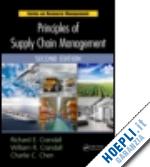Richard E. "Dick" Crandall is a professor in the College of Business at Appalachian State University (ASU), Boone, North Carolina. He is certified in production and inventory management (CFPIM) and as a supply chain professional (CSCP) by APICS-The Association for Operations Management. He earned his PhD in production/operations management from the University of South Carolina, Columbia, and is a registered professional engineer and a certified public accountant. Prior to joining ASU, Dick worked as an industrial engineer and in management positions for manufacturing and service companies. He was a consultant with a major consulting firm, installing systems for both operations and financial applications. With Rick Crandall, he coauthored the book Vanishing Boundaries, How Integrating Manufacturing and Services Creates Customer Value, by CRC Press, Taylor & Francis Group. William "Rick" Crandall currently serves as a professor of management in the School of Business at the University of North Carolina at Pembroke. He received his PhD in business administration with a focus on organizational behavior and human resource management from the University of Memphis, Tennessee. His primary research interest is in the area of crisis management, helping organizations cope with catastrophic events. He is the author of the book, Crisis Management in the New Strategy Landscape (coauthored with John Parnell and John Spillan, also of the University of North Carolina at Pembroke), released by Sage Publications. He is also active in researching issues related to supply chain management. Prior to entering higher education, Dr. Crandall worked in management for ARA Services (now ARAMARK), a service management firm based in Philadelphia. Dr. Charlie C. Chen was educated at Claremont Graduate University, California, and earned his PhD in management information systems. He is a professor in the Department of Computer Information Systems at Appalachian State University, Boone, North Carolina. His research interests include project management and supply chain management. He is a member of the Association for Information Systems and Decision Sciences Institute and is certified by the Project Management Institute as a project management professional (PMP). Dr. Chen has published in journals such as Communications of Association for Information Systems, Behaviour and Information Technology, Journal of Knowledge Management Research & Practice, and the Journal of Information Systems Education. Dr. Chen is a dedicated transnational scholar and a trip leader for study-abroad programs in Asia (Japan and Taiwan).












